
The land speed record is the highest speed achieved by a person using a vehicle on land. There is no single body for validation and regulation; in practice the Category C flying start regulations are used, officiated by regional or national organizations under the auspices of the Fédération Internationale de l'Automobile (FIA). The land speed record (LSR) is standardized as the speed over a course of fixed length, averaged over two runs. Two runs are required in opposite directions within one hour, and a new record mark must exceed the previous one by at least one percent to be validated.
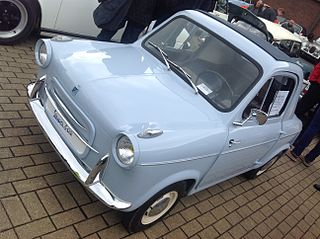
The Vespa 400 is a rear-engined microcar, produced by ACMA in Fourchambault, France, from 1957 to 1961 to the designs of the Italian Piaggio company. Three different versions were sold, the "Luxe", "Tourisme" and "GT".

The Morgan Motor Company is a British motor car manufacturer founded in 1910 by Henry Frederick Stanley Morgan and owned by the Italian investment group InvestIndustrial since March 2019.
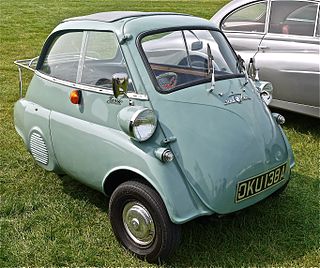
The Isetta is an Italian-designed microcar built under license in a number of different countries, including Argentina, Spain, Belgium, France, Brazil, Germany, and the United Kingdom. Because of its egg shape and bubble-like windows, it became known as a bubble car, a name also given to other similar vehicles.

A Formula One car is a single-seat, open cockpit, open-wheel racing car with substantial front and rear wings, and an engine positioned behind the driver, intended to be used in competition at Formula One racing events. The regulations governing the cars are unique to the championship and specify that cars must be constructed by the racing teams themselves, though the design and manufacture can be outsourced.

Berkeley Cars Ltd of Biggleswade, Bedfordshire, England produced economical sporting microcars with motorcycle-derived engines from 322 cc to 692 cc and front wheel drive between 1956 and 1960.

The Nissan S30 is the first generation of Z GT 3-door two-seat coupés, produced by Nissan Motors, Ltd. of Japan from 1969 to 1978. One of the most successful sports car lines ever produced, the trend-setting S30 was designed by a team led by Yoshihiko Matsuo, the head of Nissan's Sports Car Styling Studio, with the bodywork styled by Albrecht Goertz, the designer of the BMW 507.

Singer Motors Limited was a British motor vehicle manufacturing business, originally a bicycle manufacturer founded as Singer & Co by George Singer, in 1874 in Coventry, England. Singer & Co's bicycle manufacture continued. From 1901 George Singer's Singer Motor Co made cars and commercial vehicles.

The MGA is a sports car that was produced by MG from 1955 to 1962.
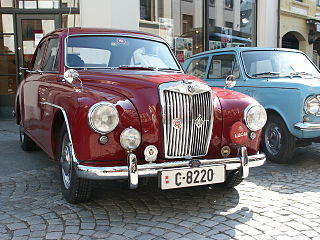
The MG Magnette is an automobile that was produced by MG between 1953 and 1968. The Magnette was manufactured in two build series, the ZA and ZB of 1953 through to 1958 and the Mark III and Mark IV of 1959 through to 1968, both using a modified Wolseley body and an Austin engine.
The Morris Isis name was first briefly used by Morris Motors Limited on a six-cylinder car made from 1929 to 1931. It was resurrected on a new six-cylinder midsize car from the British Motor Corporation in the 1950s to replace the Morris Six MS.
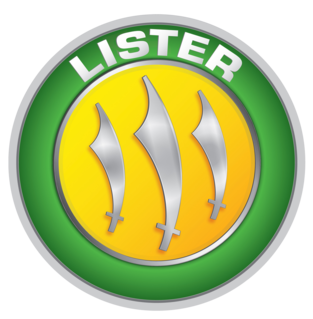
The Lister Motor Company Ltd. is a British sports car manufacturer founded by Brian Lister in 1954 in Cambridge, England, which became known for its involvement in motorsport. After buying the company in 1986, Laurence Pearce produced variants of the Jaguar XJS before producing a bespoke sports car, the Lister Storm. In 2013, Lister Cars was acquired by Lawrence Whittaker's company Warrantywise. Production of the original sports car restarted in 2014 and ten continuation Lister Jaguar Knobblys were built to celebrate Lister's 60th Anniversary. In 2016, the company announced the build and sale of the Lister Knobbly Stirling Moss. On 31 January 2018, the Lister LFT-666 based on the Jaguar F-Type was announced.

Sydney Herbert Allard was the founder of the Allard car company and a successful rally driver and hillclimb driver in cars of his own manufacture.
For the cargo bicycle producer see: Xtracycle

Bond Minicar is a series of economical three-wheeled microcars which were manufactured by the British car manufacturer Sharp's Commercials Ltd, in Preston, Lancashire, between 1949 and 1966.
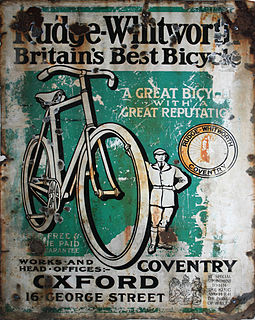
Rudge Whitworth Cycles was a British bicycle, bicycle saddle, motorcycle and sports car wheel manufacturer that resulted from the merger of two bicycle manufacturers in 1894, Whitworth Cycle Co. of Birmingham, founded by Charles Henry Pugh and his two sons Charles Vernon and John, and Rudge Cycle Co. of Coventry.
Edward Butler (1862–1940) was an English inventor who produced an early three-wheeled petrol automobile called the Butler Petrol Cycle, which is accepted by many as the first British car.
Egon Brütsch Fahrzeugbau, usually shortened to Brütsch, was a German automotive design and automaker based in Stuttgart, Baden-Württemberg.

The Castle Three was a British three-wheeled cyclecar made from 1919 to 1922 by the Castle Motor Company of Castle Mill Works, New Road, Kidderminster, Worcestershire.
The Economic was a British three-wheeled cyclecar made from 1919 to 1922 by Economic Motors of Wells Street, London, W1. It was, at £60, almost certainly the cheapest car on the British market at the time.














